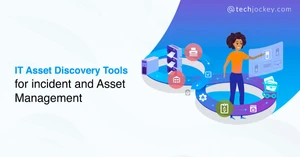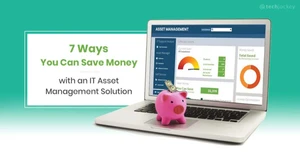What is Asset Management Software?
Asset management software is a business solution designed to record, track and manage all the assets of an organization. It records all details of an asset in every stage of its lifecycle, from procurement and maintenance to disposal.
An asset management system is crucial for an organization as it helps record, control, and regulate all the assets and document the vital information regarding them. It also tracks components, records maintenance logs, allocations, depreciation reports, compliance reports, and more.
Asset management software integrates all the asset management functions like recording details, categorizing, allocating, and tracking all tangible and intangible assets. It also helps standardize processes, improve operational efficiency and reduce costs of organizations that manage a large number of fixed and current assets.
Types of Asset Management Solutions Software
- IT Asset Management Software
If the asset is related to IT, for example, if it's hardware or software, it would be considered an IT asset, and the software used to manage them is called IT asset management software. Choosing the best hardware asset management software and the best is essential for all IT companies.
IT asset management software is a dedicated asset management software that goes beyond just recording and tracking fixed assets. It integrates all financial, contractual, and risk management aspects of software, hardware, systems, fixed assets, and other intangible assets. It provides knowledge on every IT asset's efficiency, usability, ROI, etc., to asset managers, helping them make tactical and strategical decisions related to assets.
Major Users: IT Companies, Service Providers, Law/CA firms, etc.
- Fixed Asset Management Software
This type of software tracks and manages all the fixed assets in an organization. Everything, including accounting, maintenance, and deterrence, is managed with fixed asset management software.
Fixed asset management software manages all the tangible assets of a company throughout its life cycle. It records every financial transaction related to the asset, allocation of assets, authority, maintenance logs, etc. It helps managers plan the asset's replacement in advance, monitor its actual usage against planned usage. The software performs return on investment analysis of assets purchased by the company.
Major Users: Manufacturing Companies, Small Businesses, Nursing Homes, etc.
- Digital Asset Management Software
Digital asset management software stores and organizes all the digital assets in one location. You can find everything, including pictures, videos, and other media on a single platform.
Digital asset management system tracks all the assets across all different geographical locations in real-time. It also allows to include pictures, videos, and other media with the assets. Digital asset management systems are growing trends and are extremely important for logistics companies, the transport industry, etc
Major users: Universities, Colleges, Media Houses, Logistics Industry, Real Estate Companies
- Enterprise Asset Management System
Enterprise asset management software covers all aspects of asset management like accounting, maintenance, repair, replacement, etc. It is widely used across most corporates as it can manage all types of assets. The software tracks and records information related to assets and enables users to analyse performance, conduct regular maintenance, and increase efficiency.
Major Users: Financial Institutions, Large Corporates, Coaching Institutes, Hospitals, etc.
Features of Asset Management Software Solutions
- Configuration Database Management: CDB or Configuration Database Management helps businesses record vital configuration details of each asset at a centralized place.
- Purchases and Inventory: Every purchase of the asset is captured, and purchase orders can be tracked. The stock of assets can be monitored and evaluated accurately without hassles. One can also define various contract details and rules with the help of inventory management software.
- Depreciation: Depreciation of the assets can be evaluated flawlessly and seamlessly tracked to stay updated. Depreciation of the assets can be auto-updated in the integrated accounting module or software.
- RFID: RFID tags can be attached to the assets to closely monitor Tagging asset health and service requirements.
- License Management: Licenses need to be renewed or re-purchased on time. Asset management software provides a database for license entitlements for under-licensing and over-licensing as well. The license management tool also tracks expiration dates and license terms.
- Digital Asset System Management: The asset management system includes processes for storing, organizing as well as retrieving data. The software also manages digital permission and rights. It includes media assets like photos, videos, music, podcast, and various other multimedia content.
- Report Generation: The feature of report generation is essential for any software. With asset management software, one can generate detailed pre-defined and custom reports. Query-related reports can also be produced with detailed visual graphs and figures using asset management software.
- Work Order Management: Assets should be allocated and tracked to ensure the work orders and projects are executed hassle-free with optimum efficiency. Asset management systems allow you to handle all work orders and allocate assets and other resources accordingly. Work Order management feature allows managers to monitor, assign and track work orders through a single window.
- IT Help Desk Management: Using asset management software, employees can submit, track and monitor requests related to IT assets through a centralized portal. It also enables ticket generation, follow-ups, and task delegation for a particular request.
- Maintenance Management: Assets need to be scheduled for routine maintenance and repairs for extended life. Maintenance management feature software allows managers to plan a detailed maintenance schedule for every asset based on predefined schedules, priority levels, and production efficiency.
- Asset Discovery: Asset Discovery feature of the asset management solutions system lets you find every single asset in your organization, including intangible information. It uses barcode tags, RFID, and QR codes to track every asset of the company.
- Asset Usage Tracking: The asset usage tracking feature is crucial to identify the level of wear and tear in assets. It helps managers in assigning required resources for scheduling services. It tracks and records all essential data like every asset's working hour, wastage, units produced, etc.
- Complete Lifecycle Management: Asset Accounting feature of asset management software records and logs every transaction related to the asset. It maintains details of asset transactions like procurement costs, additions, taxes, maintained costs, part replacement cost, etc., with all invoices and bills. It also helps in generating accounting ledgers, bills, and invoices related to assets for accounting purposes.
Benefits of Asset Management Software
Reliable asset recovery
If an asset is lost in the sea of other assets, it becomes difficult to trace that out. Both manpower and time are lost in this process, and several delays are caused. You can avoid all this by simply using the best asset management software in India. It has a GPS location tracking tool's feature that helps trace every asset present in the organization.
Real-time customer service
Customers often ask for the location of their assets, that too in real-time. This software lets you keep a tab on the assets at all times. You can give details about the resources or assets with their efficacy to the customers as well.
Increased productivity
An asset's lifecycle can be calculated with asset management software, which in turn increases productivity. Assets are firstly tagged with RFID tags, then they can be tracked automatically in different stages, and dedicated resources are not required to keep an eye on the assets 24x7. In this way, employees can focus on other essential tasks.
Avoid unnecessary maintenance costs
Effective repair or replacement can be planned with asset management software. Since you already have all the information, from start to end, from its buying date to all the records about its maintenance, it becomes easy to avoid additional maintenance costs. Unproductive assets can be taken care of in their earlier stages. Monitor, replace, or repair your assets on time before it's too late.
Track asset maintenance needs
You can track which assets need maintenance and when. With asset management software, it is easier to calculate the cost as well. You can set alerts for maintenance and renewal as and when needed. The inventory software can also be integrated with ticketing software which makes the whole process a lot simpler.
Set thresholds for stock renewal
Asset auditing can also be performed with the help of asset management software. Identifying ghost assets in an organization becomes essential when they increase in numbers. They cause additional maintenance, which is not required. Similarly, if an asset is about to complete its lifecycle, it can be stocked back again. You can even reduce the compliance risks with this software.
Accurate asset-related data
Using asset management software assures that the business has accurate data related to all the assets present. Tracking and auditing at different intervals would enable companies to maintain accuracy. Accuracy is also maintained as everyone in the company can keep an eye on the real-time data about the compliance, audits, and assets on the asset management software.
What Is Asset Tracking Software?
Asset tracking software is an application used to track as well as record assets throughout their lifecycle. This includes processes from their procurement to their disposal. It provides information such as the asset’s location, who all are using it, how efficient it is, and other such details. You can manage both hardware as well as software assets with asset lifecycle management software.
Latest Asset Management Software Trends
- Beyond Keeping Records: Companies like Ola and Uber are moving their businesses to 100% real-time tracking. Tracking every asset's health, location, operation, maintenance, ROI, etc., of every asset separately in real-time could be a strategic edge over the competitors. Most of the start-ups in India have thriving real-time asset management needs.
- Transforming into Asset Knowledge Base: Asset management software is moving ahead of just tracking and recording an asset. DAM software is updated as per legal compliance and record, depreciate, and report assets value as per the updated rules. Asset management software now informs users about underutilized and inefficient assets, opportunity cost, deployment strategies, and much more.
- Increasing Mobility: New-age tech-savvy consumers prefer to work on their smartphones and tablets. Organizations need to also be in a position to provide that option for their employees. This is where mobility features offered by asset management software should match the market trend. This will help organizations secure a competitive edge over other businesses in their industry.
- Valuation and ROI: The new age of asset management software solutions are built with state-of-the-art techs like AI. Asset management software can now provide precise Net realization Value, Scrap Value, and the remaining life of asset-based on industry standards, asset health, and usage. This cuts down the cost of actuarial services and helps to maintain legal compliance. Also, some AMS can calculate the present ROI and cash flow of every machinery separately, blockwise, and location-wise to provide a knowledge base for decision making.






















